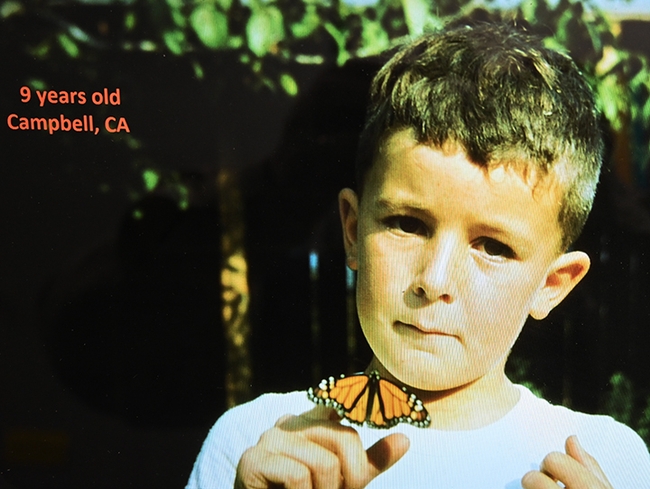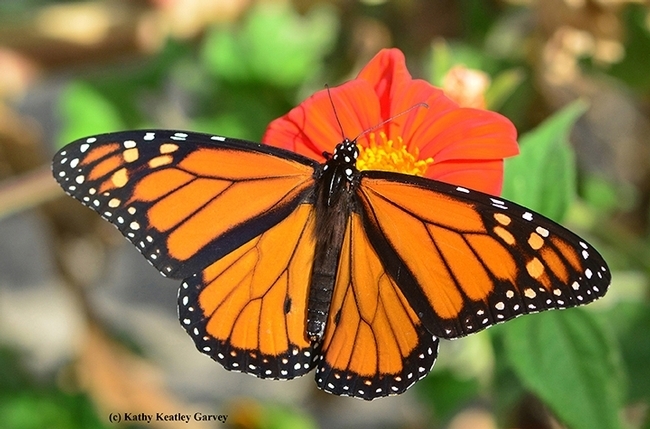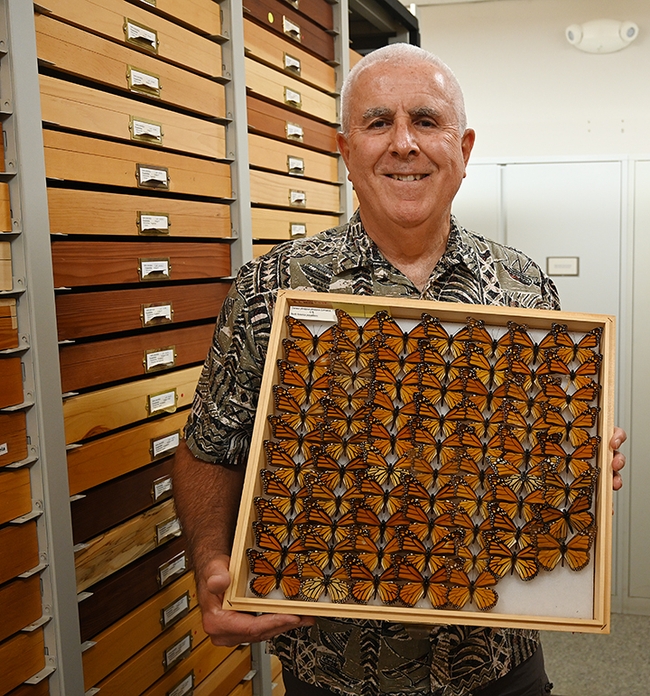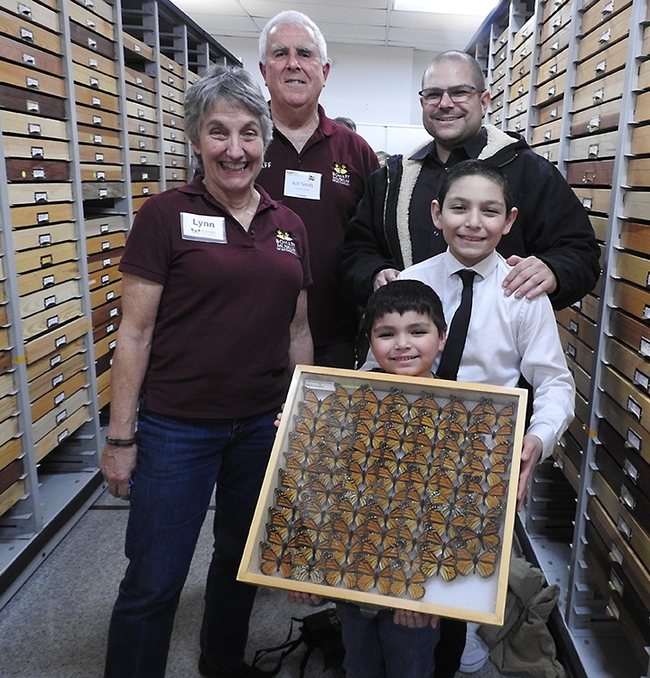
Located in Room 1124 of the Academic Surge Building, 455 Crocker Lane, the Bohart Museum houses a global collection of eight million insect specimens. Among them: 500,000 butterfly and moth specimens. The number of monarchs? Approximately 400.
"We have about seven drawers of monarch butterflies from all over the United States, from Central America, Guam, Hawaii,
Smith remembers receiving, from a Lepidopterist, "a box of about 300 DEAD monarchs that were intended to be released at a wedding but never survived until that event. I have been using these important specimens for spreading demonstrations/classes for the UC Davis Entomology Club and the summer Bio-Boot Camps, so at least they are being put to a good use and not wasted. Releasing butterflies at personal events is frowned upon by the Bohart Museum."

What's so special about monarchs? "I think the monarch has captured the hearts of so many people outside of the entomology world, and brings attention to what we do and the importance of insects," Smith said. "It's always unfortunate when disinformation is given about these or any other insects to bring confusion to science, but hopefully the Bohart Museum and our activities can correct it."
When he shows visitors the monarchs, he makes a special point to show them viceroy butterflies, often mistaken for monarchs. "The viceroy butterfly (Limenitis archippus) is the iconic mimic of the monarch, and recent studies have suggested the viceroy, too, is distasteful to predators, so this muddies our message of so many years," Smith commented.

Smith estimated the Bohart Museum "has about 3 drawers of viceroys, but from many different regions of North America, and their appearance varies dramatically. The typical orange viceroy is from the eastern United States, but those from Arizona are more of a brownish-purple and are more likely to be mimics of the other 'milkweed' butterfly there, Danaus gillippus, or The Queen."
"Mimicry works only if the model and mimic occur together," Smith pointed out. "The viceroys from Florida are MUCH larger and also very dark to mimic the Queen butterflies there. I think most people ARE surprised when they see the similarities between monarchs and viceroys, and usually ask how to tell them apart. The most consistent difference is on the hindwings, where the viceroy has a diagonal black line across the wing that monarchs do not."
For most open houses, the Bohart Museum usually opens only one aisle of butterflies (the Nymphalidae). What draws the most awe? "The biggest 'wow' butterflies are undoubtedly the huge blue Morphos from tropical Americas," Smith said. "However, the specimens of a dramatic leaf mimic, Kallima inachus, also draw amazed comments. If we are able to open other aisles, other favorites are the Atlas moths (Attacus spp.), the white witch moth (Thysania agrippina), the enormous birdwing butterflies from Eastern Asia, or the Ulysses swallowtail (Papilio ulysses) from New Guinea. The sunset moth (Chrysiridia rhipheus) from Madagscar is also unbelievable."
Smith, a volunteer, loves his job. He treasures building up the Lepidoptera collection, working with fellow Lepidopterists, and answering questions from the public. For his outstanding work, he won a 2015 “Friend of the College” award from the UC Davis College of Agricultural and Environmental Sciences.
Nominee Lynn Kimsey, director of the Bohart Museum and a UC Davis distinguished professor of entomology, commented at the time: “You could not ask for a better friend than Jeff Smith...he has brought us international acclaim and saved us $160,000 through donations of specimens and materials, identification skills and his professional woodworking skills. This does not include the thousands of hours he has donated in outreach programs that draw attention to the museum, the college and the university.” (See news story)
Kimsey praised Smith for completely reorganizing the butterfly and moth collection. “It's no small feat to rearrange this many specimens, housed in roughly one thousand drawers,” she said. “Many thousands of the specimens needed to be identified, and the taxonomy required extensive updating and reorganization.”
The Bohart Museum also houses a live "petting zoo" and an insect-themed gift shop. Founded in 1946, the Bohart is named for UC Davis professor and noted entomologist Richard Bohart, who was Kimsey's major professor. Weekend open houses are held periodically throughout the year. The Bohart is one of the co-founders and co-leaders of the campuswide Biodiversity Museum Day, also known as "Super Science Day." It is free and family friendly.
The 11 museums or collections showcasing their work on Feb. 18:
- Anthropology Museum, 328 Young Hall and grounds, noon to 4 p.m.
- Arboretum and Public Garden, Habitat Gardens in the Environmental GATEway, adjacent to the Arboretum Teaching Nursery on Garrod Drive, 9 a.m. to 1 p.m.
- Bohart Museum of Entomology, Room 1124 and main hall of the Academic Surge Building, Crocker Lane, 9 a.m. to noon and 1 to 4 p.m.
- Botanical Conservatory, the greenhouses along Kleiber Hall Drive, 11 a.m. to 3 p.m.
- California Raptor Center, 340 Equine Lane, off Old Davis Road, 9 a.m. to 3 p.m.
- Center for Plant Diversity, Sciences Laboratory Building/Esau Science Hall, off Kleiber Hall Drive, 11 a.m. to 3 p.m.
- Nematode Collection, Sciences Laboratory Building/Esau Science Hall, off Kleiber Hall Drive, 9 am. to 3 p.m.
- Marine Invertebrate Collection, Sciences Laboratory Building/Esau Science Hall, off Kleiber Hall Drive, 9 am. to 3 p.m.
- Museum of Wildlife and Fish Biology, Room 1394, Academic Surge Building, 455 Crocker Lane, 10 a.m. to 2 p.m.
- Paleontology Collection, 1309 Earth and Physical Sciences Building, 434 LaRue Road, 12 noon to 4 p.m.
- Phaff Yeast Culture Collection, Robert Mondavi Institute Brewery and Food Processing facility, Old Davis Road, 10 a.m. to 2 p.m. (See news story)
More information is available on the UC Davis Biodiversity Museum Day website.
Attached Images:

Entomologist Jeff Smith, curator of the Bohart Museum's Lepidoptera collection, holds a drawer of monarchs. (Photo by Kathy Keatley Garvey)

Michael Silva (back at right), a biotechnology professor at Solano Community College and a member of the Vacaville City Council, recently visited the Bohart with his sons Jovanni, 12, and Benjamin, 6. With them are Lynn Kimsey, director of the Bohart Museum and Lepidoptera collection curator Jeff Smith. (Photo by Kathy Keatley Garvey)